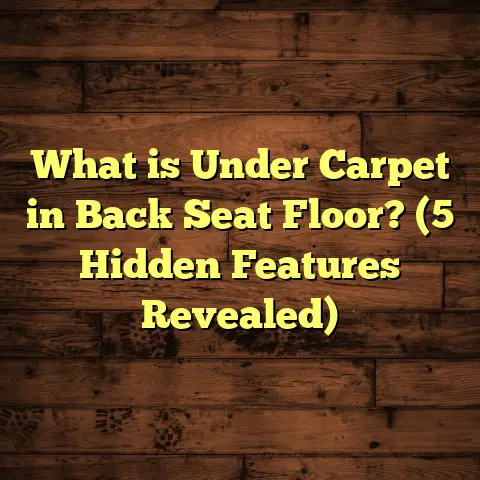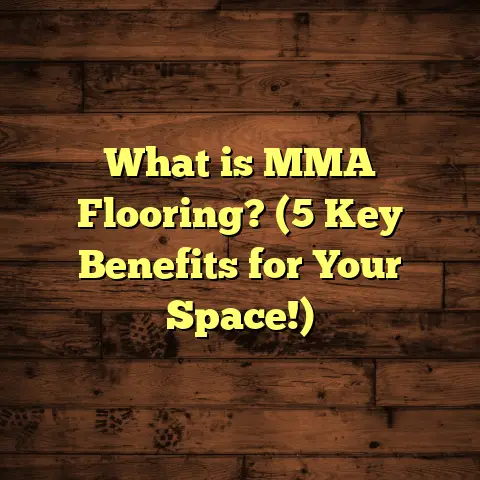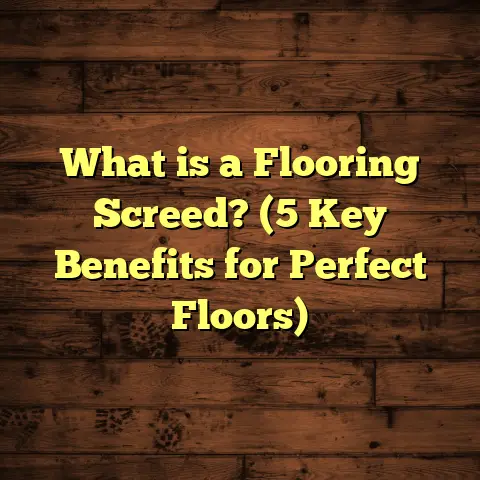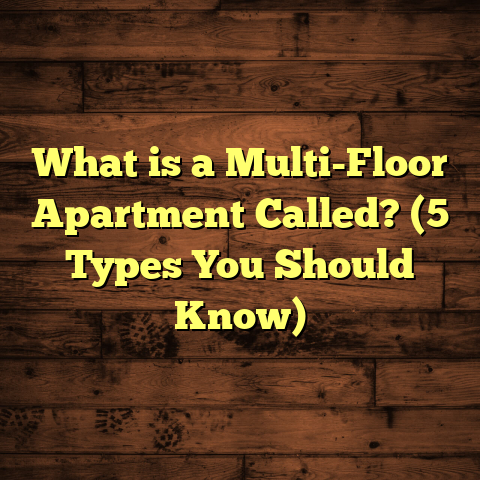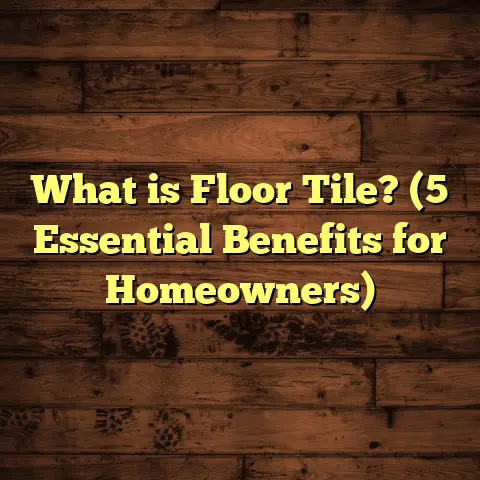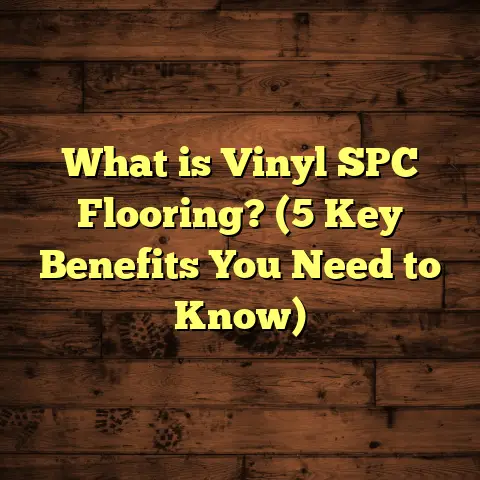What is the Average Price for Floor Buffing? (5 Cost Factors Revealed)
Allergies can turn even a cozy home into a source of discomfort. I’ve seen many people struggle with sneezing, itchy eyes, and constant congestion without realizing that their floors might be part of the problem. Dust, pet dander, pollen, and other allergens tend to settle deep into flooring surfaces, especially if those floors aren’t regularly cleaned or maintained properly. When these particles become airborne, they worsen indoor air quality and intensify allergy symptoms. Over the years, I’ve found that one overlooked yet highly effective way to combat this is through proper floor care, including a process called floor buffing.
If you’re like most homeowners, you might have heard about floor buffing but aren’t quite sure what it involves or whether it’s worth the cost. More importantly, you’re probably wondering how much it will cost you and what affects that price. I’ve worked on numerous flooring projects and helped a wide variety of clients—from busy families to allergy sufferers—get their floors looking and feeling better. In this article, I’ll share everything I’ve learned about floor buffing costs, unpack five key factors that influence pricing, and offer actionable tips so you can make smart decisions without breaking the bank.
What Is Floor Buffing and Why Should You Care?
Let’s start with what floor buffing actually is. It’s common to confuse buffing with simple cleaning or even refinishing, but it’s a distinct process that makes a big difference in both floor appearance and longevity.
Floor buffing uses a specialized machine equipped with rotating pads designed to polish the surface of your floors. The goal? To remove minor scratches, scuffs, dullness, and surface imperfections without stripping off significant layers of your flooring. This process restores shine and smoothness by smoothing out irregularities on the surface.
When I first started working in flooring maintenance, I mostly thought of buffing as a cosmetic treatment that just made floors look nicer. But over time, I realized it has practical benefits that go beyond aesthetics. Buffed floors are easier to clean because there are fewer grooves and cracks where dirt and allergens can hide. For allergy sufferers, this means less airborne dust and better indoor air quality.
For example, one client had hardwood floors that looked worn down after years of foot traffic and pet activity. Her allergies were acting up badly during springtime. After buffing and sealing the floors, she reported fewer sneezing episodes and said her home felt “fresher.” That stuck with me because it showed how floor care isn’t just about looks—it impacts comfort and health.
How Floor Buffing Differs from Other Floor Treatments
You might wonder how buffing compares to sanding or refinishing. Sanding is more aggressive and removes a thin layer of the floor’s surface to fix deep scratches or damage. Refinishing usually involves sanding followed by applying new coating or stain.
Buffing is lighter—it polishes the existing surface without removing much material. It’s typically quicker, less expensive, and better suited for floors that don’t need heavy repairs.
Picture your floor like a car’s paint job: buffing is like polishing out minor swirl marks, while sanding and refinishing are similar to repainting.
The Average Price for Floor Buffing: What Can You Expect?
Let’s get into the numbers. Based on my years of experience managing projects across different flooring types and locations, the cost for floor buffing usually falls between $0.30 to $1.50 per square foot.
That’s quite a range! So why do prices vary so much? The real answer lies in several factors that influence how much time, skill, and materials go into your specific project.
Here are the five main factors you need to understand:
1. Type of Flooring Material
One of the biggest influences on price is what kind of floor you have. Different materials respond differently to buffing and require different techniques or products.
Hardwood Floors
Buffing hardwood floors requires care so you don’t damage the wood or wear through its protective finish. Many hardwood floors have polyurethane coatings that need specific polishing pads and polishes designed for wood.
In my experience, hardwood buffing tends to be on the higher end of the price spectrum—around $0.80 to $1.50 per square foot—because it’s labor-intensive and requires skilled operators.
For instance, a project I did on a 500 sq ft oak hardwood floor involved careful buffing to avoid removing too much finish while restoring shine. The client was willing to pay a premium because she wanted her floors looking perfect for an upcoming family event.
Tile Floors
Tile floors (ceramic or porcelain) can handle more aggressive buffing but often require different pads and sometimes cleaning solutions to remove grout haze or stains.
Tile buffing prices generally run from $0.40 to $1.00 per square foot depending on the tile type and condition.
I once worked on a large tiled kitchen floor where grease buildup was an issue. Buffing combined with cleaning brought back the tile’s natural luster at a reasonable price.
Vinyl Floors
Vinyl floors are among the easiest and cheapest to buff because they are resilient and require less specialized products.
Buffing vinyl usually costs between $0.30 to $0.70 per square foot.
One client had luxury vinyl planks that looked dull after years of wear; a quick buff made them look refreshed without extra expenses.
2. Size of Your Floor Space
The size of your flooring area affects pricing in two ways: total cost and price per square foot.
Small jobs tend to have higher prices per sq ft because setup time and minimum fees make up a larger portion of total costs. For example:
- A 150 sq ft living room might be charged at $1.25 per sq ft because minimum labor hours apply.
- Larger spaces (500+ sq ft) usually get discounted rates around $0.50-$0.75 per sq ft since machines stay set up longer and labor is more efficient.
When someone asked me about buffing a 1,200 sq ft open-plan space, I quoted $0.65 per sq ft which included some volume discount compared to smaller jobs.
3. Condition of Your Floors
The current state of your floors plays a huge role in cost.
If your floors have deep scratches, stains, or damage from pets or water spills, simple buffing may not provide satisfactory results alone.
I always inspect floors before quoting. For example:
- Floors with mild surface dullness might only need buffing.
- Floors with gouges or worn finish might require sanding before buffing.
- Floors with stains might need extra cleaning steps before polishing.
If sanding or extra cleaning is required first, expect prices to rise by 30-50%. One client paid nearly double because her 400 sq ft hardwood floor needed sanding first due to deep scratches from moving furniture.
4. Labor Costs Based on Location
Where you live affects labor rates significantly.
In metropolitan areas like New York or San Francisco, labor can run $55-$75 per hour for floor services.
In smaller towns or rural areas, labor rates might be closer to $25-$40 per hour.
In my own city (a mid-sized metro area), typical labor rates hover around $45-$60 per hour depending on experience.
Higher labor costs translate into higher overall prices for buffing jobs because labor is often the largest expense component.
5. Additional Services Included
Many floor buffing contractors offer packages that include extras like:
- Deep cleaning before buffing
- Applying sealants or protective coatings afterward
- Minor repairs like filling small cracks or holes
These enhance results but add cost—usually an extra $0.50 to $1.00 per sq ft.
I often recommend sealing hardwood after buffing to extend its life and keep allergens at bay longer.
One client chose this option for her 600 sq ft floor; it added $450 to her project but gave her peace of mind knowing her floors were protected from moisture and dirt penetration.
How I Approach Cost Estimates for Clients
When someone reaches out asking for an estimate, I follow a step-by-step process:
Step 1: Measure Floor Area Accurately
I use laser measuring tools or detailed floor plans to get exact square footage since estimates rely on accurate area sizing.
Step 2: Inspect Floor Type & Condition
I look closely at flooring material plus any damage or special needs (like stain removal).
Step 3: Discuss Additional Services
Clients often want sealing or cleaning bundled; I account for those when quoting.
Step 4: Factor in Labor Rates & Location
I adjust pricing based on local market labor costs as well as travel time if applicable.
Step 5: Include Waste & Contingency
I add a buffer for unforeseen issues like unexpected repairs or excess materials needed—usually 5-10% of total cost.
This approach reduces surprises and helps clients plan budgets realistically.
Real Project Examples From My Work
Here are some real-world numbers from my past jobs:
Project A – Hardwood Buffing
- Location: Urban residential home
- Size: 350 sq ft oak hardwood
- Condition: Mild scratches, good finish
- Labor rate: $55/hour
- Price per sq ft: $1.25
- Total cost: $437.50
The client was thrilled with how shiny her floors looked after just one day’s work.
Project B – Vinyl Buffing
- Location: Suburban office space
- Size: 600 sq ft luxury vinyl planks
- Condition: Good; no stains or damage
- Labor rate: $40/hour
- Price per sq ft: $0.45
- Total cost: $270
Buffing revived the dull vinyl without needing extra treatments.
Project C – Tile Buffing + Stain Removal
- Location: Commercial kitchen
- Size: 500 sq ft ceramic tiles
- Condition: Grease stains present
- Labor rate: $50/hour
- Price per sq ft (with stain removal): $0.95
- Total cost: $475
Extra cleaning made a noticeable difference before polishing tiles back to life.
Tips for Keeping Floor Buffing Costs Manageable
Want to save money but still get great results? Here are some practical tips I share frequently:
Maintain Regular Cleaning
Dust and grime buildup make buffing harder and more expensive because deeper cleaning steps may be needed first. Sweeping or vacuuming regularly keeps dirt from embedding deeply in your floors.
Don’t Wait Too Long
Delaying buffing until floors are badly damaged leads to higher costs due to necessary repairs like sanding or stain removal beforehand.
Get Multiple Quotes
Prices can vary widely between contractors—sometimes by as much as 50%. I always recommend getting at least three quotes so you know what’s fair locally.
Combine Services When Possible
If you need other floor services (cleaning, sealing), bundle them together with one provider for possible discounts on labor or materials.
DIY Prep Helps
Clearing furniture out of rooms yourself before pros arrive saves labor time and reduces your invoice amount.
Can Floor Buffing Help With Allergies?
Absolutely yes! This is something I’ve seen firsthand with clients who suffer from allergies or respiratory conditions like asthma.
Buffed floors have fewer cracks and rough spots where allergens accumulate—making regular cleaning more effective at removing dust mites and pet dander.
One client told me she noticed fewer sneezing fits after we buffed and sealed her hardwood floors—she even said her kids slept better at night!
If allergies are an issue in your home, investing in floor buffing combined with sealing can significantly improve indoor air quality over time.
How Often Should You Buff Your Floors?
A very common question clients ask me is how frequently they should schedule buffing services.
The answer depends on:
- Foot traffic intensity (busy homes/offices need more frequent care)
- Floor type (hardwood may need annual buffing; vinyl less often)
- Condition (older floors may benefit from more frequent maintenance)
Generally speaking:
| Floor Type | Recommended Buffing Frequency |
|---|---|
| Hardwood | Every 12 months |
| Tile | Every 6-12 months |
| Vinyl | Every 18-24 months |
Doing it regularly prevents heavy buildup that requires costly repairs later on.
What Should You Look For When Hiring a Floor Buffing Contractor?
Choosing the right company can affect both price and quality of results tremendously. Here’s what I advise clients to check:
- Experience: How long have they been doing floor buffing? Ask for references.
- Equipment Quality: Are they using modern machines with proper pads?
- Materials Used: Do they use safe polishes appropriate for your flooring type?
- Insurance: Ensure they carry liability insurance in case of accidents.
- Warranty: Some contractors offer satisfaction guarantees or warranties on their work.
- Transparent Pricing: They should provide clear written estimates detailing all costs upfront.
- Reviews: Check online reviews to see what past customers say about reliability and results.
A Deeper Look at Costs — Breaking Down Labor vs Materials
Let me give you some insight into where your money goes during floor buffing projects:
Labor Costs
Labor usually makes up 60%-70% of total costs because skilled operators are needed for effective polishing without damage risks.
Time spent includes setup, actual buffing, cleanup, minor repairs if needed, and sometimes applying sealants afterward.
Typical labor rates vary widely but tend to average:
| Region Type | Hourly Labor Rate |
|---|---|
| Large Metro Areas | $55 – $75 |
| Suburban Areas | $40 – $55 |
| Rural Areas | $25 – $40 |
Materials & Supplies
Materials include polishing pads (which wear out quickly), polishes/waxes/sealants tailored for your floor type, cleaning products used prior to buffing, plus any minor repair fillers if needed.
Materials usually account for 20%-30% of total costs but can increase if premium sealants are chosen ($0.50-$1 per sq ft extra).
Can You Buff Floors Yourself?
Some people ask if they can do floor buffing themselves using rental machines or home equipment. It is possible but comes with risks:
- Improper pad choice or technique can damage floors.
- Buffing machines require some skill for even polishing.
- Heavy machines can be difficult to handle safely.
- You might not get professional-grade results without proper products.
- Some hardwood finishes are sensitive; wrong polish may cause discoloration or wear-through.
If you’re handy and want to try DIY on small areas like entryways or halls, go ahead with rental machines from hardware stores but test on small hidden spots first.
For larger spaces or valuable floors, hiring professionals is safer and usually more cost-effective long-term considering potential damage costs avoided.
How Technology Has Made Floor Buffing More Affordable & Effective
Over time, advances in floor care technology have improved efficiency and lowered some costs:
- Modern rotary buffers use variable speeds allowing tailored polishing without damage.
- Eco-friendly polishes reduce harmful emissions indoors.
- Dust containment systems attached to machines prevent allergen spread during work.
- Better quality pads last longer reducing replacement frequency.
These innovations mean you’re more likely to get better results faster than even five years ago—a good reason not to skip professional services if budget allows!
Final Thoughts
Floor buffing is more than just making your floors shine again; it improves cleanliness, reduces allergens trapped in flooring surfaces, protects your investment, and enhances your home’s overall comfort level.
Knowing what affects costs—from flooring types through labor rates—gives you power over budgeting decisions so you can get great results without overspending.
Remember these five key cost factors when planning:
- Type of flooring material matters most.
- Size affects total cost but bigger spaces sometimes mean lower unit prices.
- Floor condition influences whether extra repair steps are needed.
- Location impacts labor costs dramatically.
- Extras like sealing add value but also increase price slightly.
If you want a personalized estimate for your home’s flooring project or advice on maintenance schedules that suit your lifestyle and budget, just ask! Helping people protect their homes while improving air quality through smart floor care has been my passion for years—and I’m happy to share everything I’ve learned along the way.
If you want me to help calculate an estimate based on your exact room size or flooring type using tools like FloorTally—or if you want practical tips tailored specifically for your allergy concerns—I’m here anytime!
